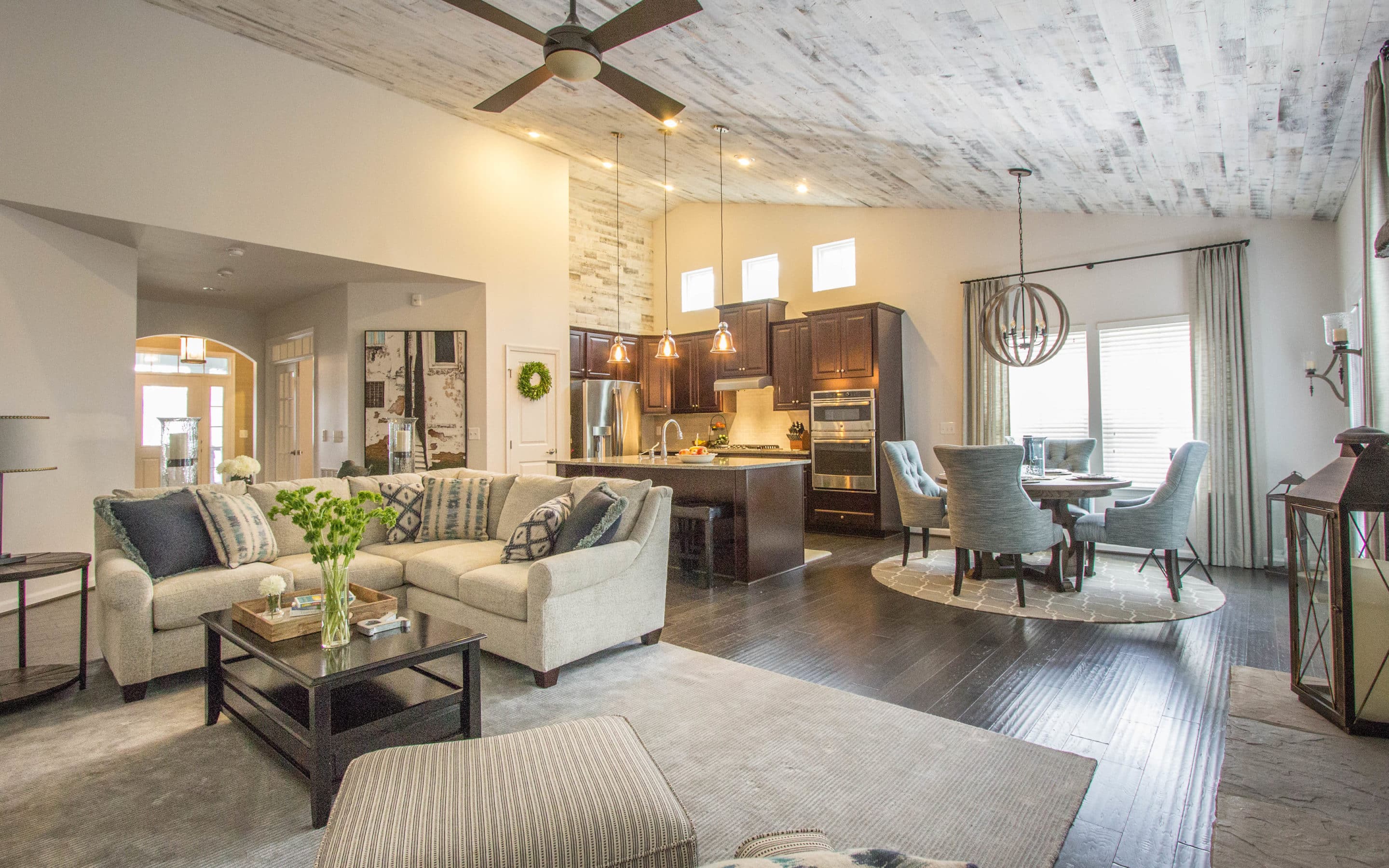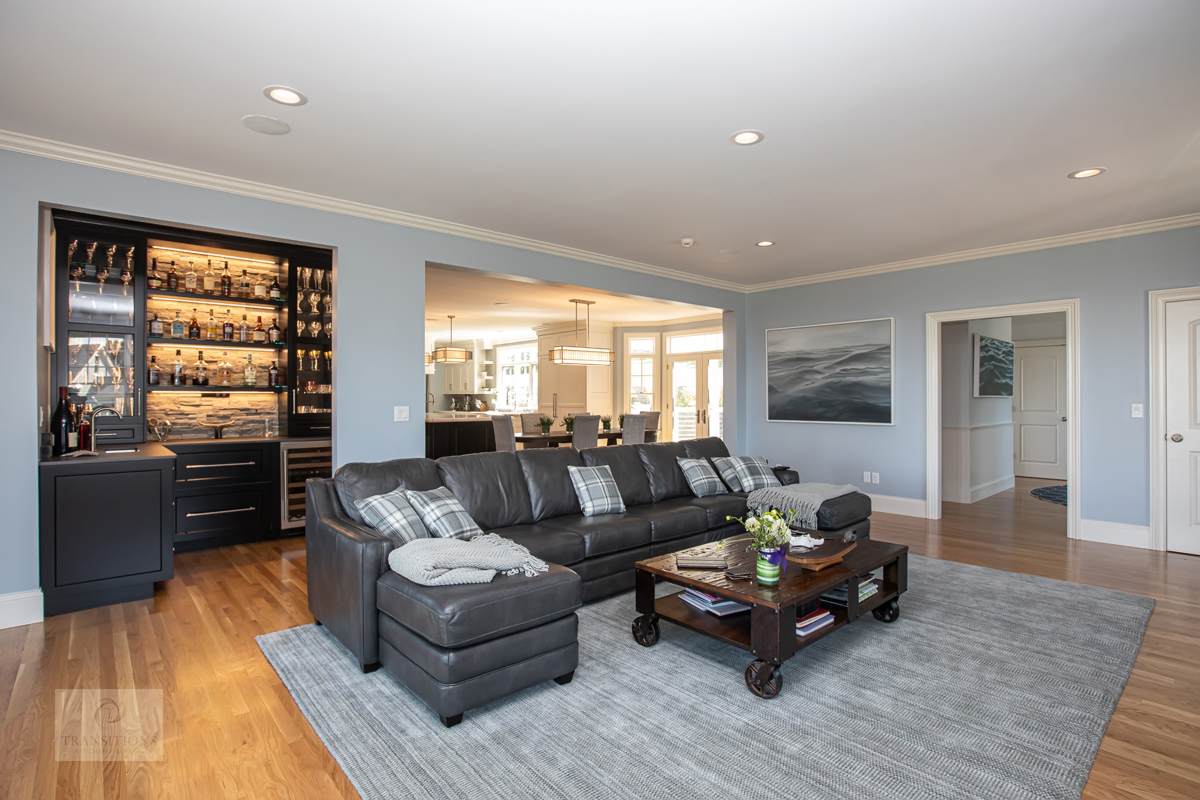Ways to Tie In Kitchen And Living Room Together
The kitchen and living room are two essential spaces in any home. The kitchen is where we cook and gather to eat, while the living room is where we relax and entertain. These two rooms may have different functions, but that doesn't mean they can't be seamlessly connected. In fact, tying in the kitchen and living room together can create a cohesive and functional space that is perfect for modern living. Here are 10 ways to achieve that perfect blend.
Tips for Blending Kitchen And Living Room
When it comes to blending the kitchen and living room, it's all about creating a sense of flow and continuity. One of the best ways to achieve this is by using a consistent color scheme throughout both rooms. This doesn't mean you have to paint everything the same color, but rather use complementary colors or shades of the same color to tie the rooms together. For example, if your kitchen has light blue cabinets, you can use a similar shade of blue for the accent pillows in your living room.
Creative Ideas for Combining Kitchen And Living Room
Another way to tie in the kitchen and living room is by using similar materials and finishes. For example, if your kitchen has a marble countertop, you can incorporate marble accents in the living room such as a coffee table or lamp base. This creates a cohesive look that ties the two spaces together. You can also use similar flooring throughout both rooms, such as hardwood or tile, to create a seamless transition between them.
How to Create a Cohesive Kitchen And Living Room Design
When designing a cohesive kitchen and living room, it's important to consider the layout of both spaces. If possible, try to create an open floor plan where the two rooms flow into each other. This will not only make the space feel larger but also make it easier to connect the two rooms. You can also use furniture placement to create a natural flow between the kitchen and living room. For example, placing a barstool at the kitchen counter that faces the living room can help tie the two spaces together.
Best Practices for Integrating Kitchen And Living Room
To seamlessly integrate the kitchen and living room, it's important to pay attention to the small details. For example, using similar hardware for cabinets and drawers in both rooms can create a sense of continuity. You can also incorporate similar lighting fixtures throughout both spaces to create a cohesive look. Another great tip is to use a consistent design style in both rooms, whether it's modern, farmhouse, or traditional. This will help create a cohesive and harmonious space.
Design Inspiration for a Unified Kitchen And Living Room
If you're unsure of how to tie in your kitchen and living room, there are plenty of design inspirations to draw from. Look at interior design magazines, websites, and social media platforms like Pinterest for ideas. You can also consult with a professional interior designer who can help you create a cohesive and functional space. Don't be afraid to get creative and think outside the box to find inspiration for your combined kitchen and living room design.
Key Elements for a Seamless Kitchen And Living Room Transition
There are a few key elements to keep in mind when trying to achieve a seamless transition between the kitchen and living room. First, consider the traffic flow in both rooms. Make sure there is enough space for people to move around comfortably without feeling cramped. Second, pay attention to the sightlines between the two rooms. You want to create a sense of connection and openness, so avoid placing large furniture or objects that may block the view between the kitchen and living room.
Incorporating Similar Colors and Materials in Kitchen And Living Room
As mentioned before, using similar colors and materials is a great way to tie in the kitchen and living room. But it's also important to strike a balance between the two rooms. You don't want everything to be matchy-matchy, as it can make the space feel boring and lack character. Instead, use complementary colors and mix and match materials to create a cohesive yet interesting look. For example, if your kitchen has a white subway tile backsplash, you can use a different color or shape of tile for the living room fireplace surround.
Using Furniture and Decor to Connect Kitchen And Living Room
Furniture and decor play a significant role in tying in the kitchen and living room. As mentioned earlier, furniture placement can create a sense of flow between the two spaces. But you can also use similar furniture styles, patterns, and textures to connect the two rooms. For example, if your living room has a striped area rug, you can incorporate a similar pattern in your kitchen with a striped dish towel or table runner. This will create a visual connection between the two spaces.
Maximizing Space and Functionality in a Combined Kitchen And Living Room
Combining the kitchen and living room can also help maximize space and functionality in your home. By eliminating walls and creating an open floor plan, you can make the space feel larger and more inviting. You can also incorporate multi-functional furniture, such as a kitchen island with built-in seating that can double as a dining table or a sofa with hidden storage in the living room. This will not only make the space more functional but also help tie the two rooms together.
Tie In Kitchen And Living Room Together: A Key Element in Creating Cohesion in House Design

Why Cohesion is Important in House Design
 In today's modern world, the kitchen and living room have become central gathering spaces in homes. They are not just places for cooking and relaxation but also serve as social hubs for family and friends. With this in mind, it is essential to have a cohesive design between these two areas to create a seamless flow and enhance the overall aesthetic of your home.
Cohesion
refers to the harmonious relationship between different elements in a space. In house design, it is crucial to create a sense of unity and connection between rooms to avoid a disjointed and cluttered look. When it comes to the kitchen and living room, this is especially important as they are often located next to each other and are frequently used together.
In today's modern world, the kitchen and living room have become central gathering spaces in homes. They are not just places for cooking and relaxation but also serve as social hubs for family and friends. With this in mind, it is essential to have a cohesive design between these two areas to create a seamless flow and enhance the overall aesthetic of your home.
Cohesion
refers to the harmonious relationship between different elements in a space. In house design, it is crucial to create a sense of unity and connection between rooms to avoid a disjointed and cluttered look. When it comes to the kitchen and living room, this is especially important as they are often located next to each other and are frequently used together.
Ways to Tie in the Kitchen and Living Room Together
 One of the most effective ways to tie in the kitchen and living room is through
color coordination
. Choose a color scheme that flows seamlessly between the two areas, such as using the same color palette with different shades or incorporating complementary colors. This will create a visual connection between the two spaces, making them feel like one cohesive unit.
Another way to tie in the kitchen and living room is through
matching materials and textures
. For instance, if you have wooden cabinets in the kitchen, consider incorporating wooden elements in the living room, such as a coffee table or shelves. This will create a sense of consistency and unity between the two areas.
One of the most effective ways to tie in the kitchen and living room is through
color coordination
. Choose a color scheme that flows seamlessly between the two areas, such as using the same color palette with different shades or incorporating complementary colors. This will create a visual connection between the two spaces, making them feel like one cohesive unit.
Another way to tie in the kitchen and living room is through
matching materials and textures
. For instance, if you have wooden cabinets in the kitchen, consider incorporating wooden elements in the living room, such as a coffee table or shelves. This will create a sense of consistency and unity between the two areas.
Maximizing Functionality and Space
 In addition to creating a cohesive design, tying in the kitchen and living room can also help maximize functionality and space in your home. By creating a seamless flow between the two areas, you can
improve the functionality of your kitchen
. For example, having an open layout between the kitchen and living room allows for easier movement and communication while cooking and entertaining guests.
Moreover, tying in the kitchen and living room can also help
create the illusion of more space
. When the two areas blend seamlessly, it gives the impression of a larger, more open space. This is particularly beneficial for smaller homes or apartments where space is limited.
In addition to creating a cohesive design, tying in the kitchen and living room can also help maximize functionality and space in your home. By creating a seamless flow between the two areas, you can
improve the functionality of your kitchen
. For example, having an open layout between the kitchen and living room allows for easier movement and communication while cooking and entertaining guests.
Moreover, tying in the kitchen and living room can also help
create the illusion of more space
. When the two areas blend seamlessly, it gives the impression of a larger, more open space. This is particularly beneficial for smaller homes or apartments where space is limited.
In Conclusion
 In conclusion, tying in the kitchen and living room is a key element in creating cohesion in house design. It not only enhances the overall aesthetic of your home but also improves functionality and maximizes space. By using color coordination, matching materials and textures, and creating a sense of unity between the two areas, you can achieve a cohesive and visually appealing home design. So next time you're planning a home renovation, don't forget to consider the importance of tying in the kitchen and living room together.
In conclusion, tying in the kitchen and living room is a key element in creating cohesion in house design. It not only enhances the overall aesthetic of your home but also improves functionality and maximizes space. By using color coordination, matching materials and textures, and creating a sense of unity between the two areas, you can achieve a cohesive and visually appealing home design. So next time you're planning a home renovation, don't forget to consider the importance of tying in the kitchen and living room together.



























































































/Bright-Beach-House-Living-Room-589a537e5f9b5874eec9dbd6.png)



